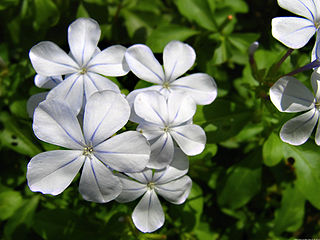
A shrub or bush is a small-to-medium-sized perennial woody plant. Unlike herbaceous plants, shrubs have persistent woody stems above the ground. Shrubs can be either deciduous or evergreen. They are distinguished from trees by their multiple stems and shorter height, less than 6–10 m (20–33 ft) tall. Small shrubs, less than 2 m (6.6 ft) tall are sometimes termed as subshrubs. Many botanical groups have species that are shrubs, and others that are trees and herbaceous plants instead.

Gaillardia is a genus of flowering plants in the family Asteraceae, native to North and South America. It was named after Maître Gaillard de Charentonneau, an 18th-century French magistrate who was an enthusiastic botanist. The common name may refer to the resemblance of the inflorescence to the brightly patterned blankets made by Native Americans, or to the ability of wild taxa to blanket the ground with colonies. Many cultivars have been bred for ornamental use.

Copper Canyon is a group of six distinct canyons in the Sierra Madre Occidental in the southwestern part of the state of Chihuahua in northwestern Mexico that is 65,000 square kilometres (25,000 sq mi) in size. The canyons were formed by six rivers that drain the western side of the Sierra Tarahumara. All six rivers merge into the Rio Fuerte and empty into the Gulf of California. The walls of the canyon are a copper/green color, which is the origin of the name.

The Rarámuri or Tarahumara are a group of Indigenous people of the Americas living in the state of Chihuahua in Mexico. They are renowned for their long-distance running ability.

Plumbaginaceae is a family of flowering plants, with a cosmopolitan distribution. The family is sometimes referred to as the leadwort family or the plumbago family.

Gaillardia pulchella is a North American species of short-lived perennial or annual flowering plants in the sunflower family.

Vernonia is a genus of about 350 species of forbs and shrubs in the family Asteraceae. Some species are known as ironweed. Some species are edible and of economic value. They are known for having intense purple flowers. There have been numerous distinct subgenera and subsections named in this genus, and some botanists have divided the genus into several distinct genera. For instance, the Flora of North America recognizes only about twenty species in Vernoniasensu stricto, seventeen of which are in North America north of Mexico, with the others being found in South America.

Pereskiopsis is a genus of cactus in the subfamily Opuntioideae. Unlike typical cacti, it has persistent fleshy leaves. The genus name refers to its resemblance to the genus Pereskia. Most species are found in Mexico south through Guatemala to Honduras, with one species in Bolivia. The incorrect spelling Peireskiopsis has also been used.

Plumbago is a genus of 10–20 species of flowering plants in the family Plumbaginaceae, native to warm temperate to tropical regions of the world. Common names include plumbago and leadwort.

Ligusticum porteri, also known as oshá, wild parsnip, Porter’s Lovage or wild celery, is a perennial herb found in parts of the Rocky Mountains and northern New Mexico, especially in the southwestern United States.

Pinole, also called pinol or pinolillo, is roasted ground maize, which is then mixed with a combination of cocoa, agave, cinnamon, chia seeds, vanilla, or other spices. The resulting powder is then used as a nutrient-dense ingredient to make different foods, such as cereals, baked goods, tortillas, and beverages. The name comes from the Nahuatl word pinolli, meaning cornmeal. Today, pinole is generally made by hand using wood-burning adobe ovens and a stone and pestle, and is still consumed in certain, often rural, parts of Latin America. Pinole is considered the national beverage of Nicaragua and Honduras.

The Tarahumara language is a Mexican Indigenous language of the Uto-Aztecan language family spoken by around 70,000 Tarahumara (Rarámuri/Ralámuli) people in the state of Chihuahua, according to a 2002 census conducted by the government of Mexico.

A protocarnivorous plant, according to some definitions, traps and kills insects or other animals but lacks the ability to either directly digest or absorb nutrients from its prey like a carnivorous plant. The morphological adaptations such as sticky trichomes or pitfall traps of protocarnivorous plants parallel the trap structures of confirmed carnivorous plants.

Plumbago auriculata, the Cape leadwort, blue plumbago or Cape plumbago, is a species of flowering plant in the family Plumbaginaceae, native to South Africa and Mozambique.

Fernando Altamirano was a Mexican physician, botanist and naturalist. He was born in Aculco, studied in Querétaro, and died in Mexico City. Altamirano was the founder and the director of the Instituto Medico Nacional from 1888 to 1908.

Leptotes cassius, the Cassius blue or tropical striped blue, is a butterfly of the family Lycaenidae. It is found in North America in Florida including the Keys, Texas south through the Caribbean, Mexico, and Central America to South America. Strays have been found in New Mexico, Kansas, Missouri, South Carolina, North Carolina and Virginia.

Azalein is a chemical compound. It is a flavonol, a type of flavonoid. It is the 3-O-α-L-rhamnoside of azaleatin. It can be found in the flowers of Plumbago and Rhododendron species.

Pulchellidin (Pl) is an O-methylated anthocyanidin. It is a blue-red plant pigment. It can be found in Plumbago pulchella.

Plumbago zeylanica, commonly known as Ceylon leadwort, doctorbush or wild leadwort, is a species of plumbago with a pantropical distribution. Carl Linnaeus described the paleotropical P. zeylanica and Neotropical P. scandens as separate species, but they are currently considered synonymous.

Hermannia is a genus of flowering plants in the mallow family, Malvaceae. It comprises at least 65 species with many more species as yet unresolved.

















